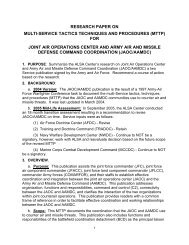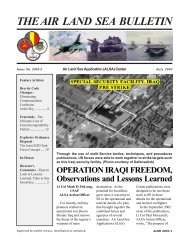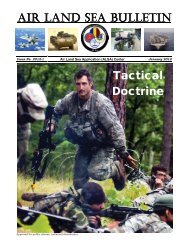AIR LAND SEA BULLETIN Attack the Network - ALSA
AIR LAND SEA BULLETIN Attack the Network - ALSA
AIR LAND SEA BULLETIN Attack the Network - ALSA
Create successful ePaper yourself
Turn your PDF publications into a flip-book with our unique Google optimized e-Paper software.
… <strong>the</strong> fundamental<br />
principles in <strong>the</strong><br />
Western way of<br />
war do not apply<br />
well to conducting<br />
COIN.<br />
lethality. However, most adversaries<br />
realize <strong>the</strong>y cannot fight a superior<br />
military force ―toe-to-toe,‖ and thus<br />
<strong>the</strong>y employ insurgency-type operations<br />
which are becoming standard<br />
operating procedures for non-state<br />
actors. The principle foundations of<br />
<strong>the</strong> Western way of war have been<br />
used by nearly every Western nation<br />
conducting modern warfare. Historical<br />
examples include: <strong>the</strong> Prussians<br />
revolutionizing <strong>the</strong>ir Army through<br />
leadership training and instilling superb<br />
discipline in <strong>the</strong>ir Soldiers; German<br />
forces using railroads to<br />
mobilize resources during World War<br />
I; and <strong>the</strong> technological advance of<br />
<strong>the</strong> needle gun (a firearm with a<br />
needle-like firing pin) that was<br />
proclaimed as <strong>the</strong> ―key to Prussian<br />
victory‖ at Königgrätz in 1866. 3<br />
Although historical examples<br />
show that military victories can be<br />
attributed to using <strong>the</strong> principle<br />
foundations of <strong>the</strong> Western way of<br />
war, <strong>the</strong>se foundations may contribute<br />
to defeat in <strong>the</strong> current era of<br />
warfare. The reason for this is <strong>the</strong><br />
battlefield and enemy has changed<br />
drastically from what <strong>the</strong>y were just<br />
50 years ago. Current battlefields<br />
and enemies are hidden within<br />
populations, and <strong>the</strong> dominant form<br />
of warfare for <strong>the</strong> US today is<br />
counterinsurgency (COIN). There are<br />
different principles of warfare that<br />
need to be applied to ensure success<br />
in COIN operations, such as in<br />
Afghanistan. Consequently, <strong>the</strong> US<br />
will be unsuccessful in Afghanistan<br />
because <strong>the</strong> fundamental principles<br />
in <strong>the</strong> Western way of war do not<br />
apply well to conducting COIN.<br />
Using superior technology is<br />
not <strong>the</strong> best way to ga<strong>the</strong>r information<br />
and fight <strong>the</strong> enemy in COIN<br />
operations. Technologically superior<br />
weapons and reconnaissance systems<br />
will work at <strong>the</strong> tactical level. However,<br />
<strong>the</strong> over-reliance on technology<br />
distracts coalition forces from focusing<br />
on <strong>the</strong> best method of ga<strong>the</strong>ring<br />
information and building trust<br />
and rapport with <strong>the</strong> local populace<br />
ALSB 2012-2 22<br />
that will ultimately help us achieve<br />
strategic victory. The best method of<br />
ga<strong>the</strong>ring information in a COIN environment<br />
is through human intelligence<br />
(HUMINT) where information<br />
is ga<strong>the</strong>red by talking to people and<br />
building trust and relationships. In a<br />
COIN environment, <strong>the</strong> enemy is not<br />
always easily identifiable. For example,<br />
one day a man may be farming<br />
his land and <strong>the</strong> next day <strong>the</strong> same<br />
man emplaces an improvised explosive<br />
device (IED) intended to kill coalition<br />
forces. This example highlights<br />
<strong>the</strong> predominant enemy coalition<br />
forces are facing in Afghanistan.<br />
The best way to identify this<br />
type of enemy is through people<br />
informing military or government authorities<br />
about suspicious or illegal<br />
activities. The US, and o<strong>the</strong>r countries,<br />
have used imagery to correlate pattern-of-life<br />
activities with vehicles<br />
planting IEDs and forensic evidence<br />
found at a detonation site to link<br />
people to such acts using biometric<br />
databases. The problem is: using technology<br />
does not prevent <strong>the</strong> enemy<br />
from acting, which renders superior<br />
technology of little use unless it can<br />
catch <strong>the</strong> enemy in <strong>the</strong> act. Catching<br />
<strong>the</strong> enemy in <strong>the</strong> act is extremely difficult<br />
to do. In addition, superior technology<br />
in weaponry may be good for<br />
risk mitigation by allowing standoff<br />
for friendly forces, but it does not allow<br />
for selective and precise targeting<br />
of individuals. There may be many<br />
individuals located at an objective,<br />
but not all are hostile combatants.<br />
Striking targets with smart weapons<br />
may cause collateral damage in <strong>the</strong><br />
form of non-enemy deaths resulting<br />
in solidifying support against coalition<br />
forces from <strong>the</strong> relatives of casualties.<br />
In both cases, technology is<br />
doing what it was designed to do, but<br />
<strong>the</strong> enemy has already succeeded by<br />
carrying out its propaganda act or<br />
increasing support for its cause<br />
when coalition forces accidently kill<br />
neutral or friendly bystanders, thus<br />
denigrating superior technology contributions<br />
to strategic victory in a<br />
COIN environment.





